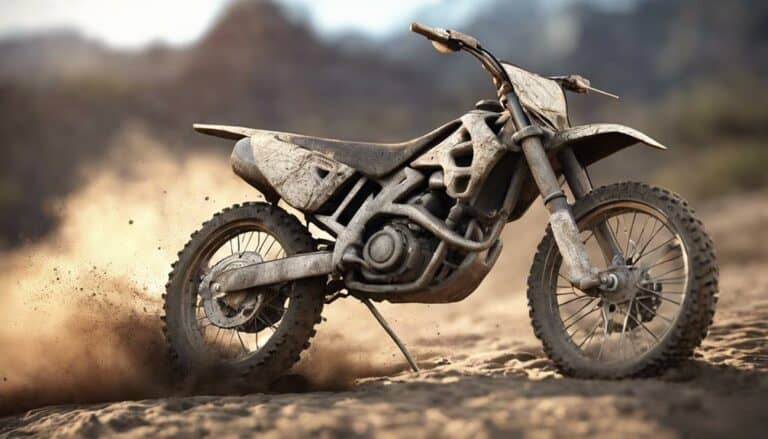When it comes to effective braking on dirt bike terrain, remember the old adage: 'You can't reinvent the wheel.' The tires on your dirt bike are more than just rubber – they are your lifeline to control and safety.
But have you ever stopped to think about the intricate role they play in achieving that perfect stop on challenging terrain? Let's explore how the right tire choice can make all the difference in your braking performance and control on dirt bike trails.
Key Takeaways
- Tire tread patterns directly impact braking efficiency by enhancing grip and traction.
- Proper tire selection matching terrain types optimizes braking performance on dirt bike terrain.
- Tire compounds and construction influence stopping power and stability during braking maneuvers.
- Tailoring tire pressures and designs to terrain conditions enhances overall braking effectiveness.
Importance of Tire Selection for Braking
When considering the importance of tire selection for braking on a dirt bike, the grip and traction provided by the tires play a critical role in determining braking efficiency.
The front and rear tires of your dirt bike are the key components that interact with the terrain during braking maneuvers. The grip levels of these tires directly impact how quickly and effectively you can decelerate.
Proper tire selection tailored to the specific terrain you ride on guarantees peak braking performance. Whether you're traveling through loose gravel, muddy tracks, or hard-packed dirt, having the right tires can make all the difference in your ability to brake confidently.
The tread pattern of your tires also plays an essential role in braking, as it determines how the tires bite into the ground, providing the necessary traction to stop efficiently.
Tire Tread Design and Braking Performance
The effectiveness of dirt bike braking maneuvers greatly hinges on the design of the tire tread, specifically its influence on traction and grip across various terrain types. When it comes to tire tread design and braking performance, several key factors come into play:
- Knobby tire patterns: These patterns provide better bite and traction, important for effective braking in dirt bike terrain.
- Tread depth and spacing: Impact the tire's ability to shed mud and maintain grip during braking maneuvers.
- Sharp edges: Present in the tire tread enhance braking control, especially on loose or slippery surfaces.
- Siping: The presence of small slits in the tread contributes to improved grip and stability during braking.
- Tire compounds and construction: Also play a significant role in braking efficiency, providing necessary grip and feedback for effective stopping power.
Considering these aspects of tire tread design can greatly enhance your dirt bike braking performance, ensuring better control and safety on challenging terrains.
Factors Influencing Tire Braking Efficiency
Factors that influence tire braking efficiency on dirt bike terrain encompass a combination of tire compound, tread pattern, tire inflation, tire condition, tire width, tire profile, and terrain type.
The tire compound and tread pattern play an important role in providing the necessary grip and traction for effective braking maneuvers on different surfaces.
Maintaining proper tire inflation levels is essential to make sure an ideal contact patch size, maximizing braking performance. Additionally, the condition of the tire, including tread wear and damage, directly impacts braking efficiency.
The width and profile of the tire contribute to stability and control during braking, influencing overall stopping power.
Choosing the right tire based on the terrain type, whether it's hard or soft, is key to achieving efficient braking on dirt bike terrain.
Techniques for Optimizing Braking With Tires
Optimizing braking performance with your dirt bike tires requires implementing specific techniques that leverage tire grip and traction effectively. To enhance your braking efficiency, consider the following techniques:
- Adjust Tire Pressures: Matching tire pressures to the terrain conditions can greatly improve braking control and grip on varying surfaces.
- Choose the Right Tread Patterns: Opt for tires with aggressive tread patterns that can grip the ground better, especially during braking maneuvers.
- Select the Appropriate Rubber Compound: Soft compound tires offer superior grip, enhancing your stopping power and overall braking performance.
- Understand Tread Design: Consider the tire's tread design to make sure it complements the terrain you'll be riding on, maximizing braking efficiency.
- Experiment and Adapt: Test different combinations of tire pressures, tread patterns, and rubber compounds to find the best setup for your dirt bike and the terrain conditions you encounter.
Matching Tires to Terrain for Braking
Selecting appropriate tires based on terrain characteristics influences your dirt bike's braking performance. When choosing tires for your dirt bike, consider the terrain type you'll be riding on. Opting for soft compound tires can greatly enhance braking efficiency, especially on hard surfaces. The tread pattern is also essential, with knobby tires providing the necessary traction for effective braking in various off-road conditions. Matching the tire design to the specific terrain type is key; for instance, using soft compound tires on dry, hard terrains can optimize braking performance by improving grip.
The right tire construction and compound selection play a crucial role in ensuring braking stability and control, essential for safe riding. By carefully selecting tires that suit the terrain you'll be traveling, you can maximize braking power and control, ultimately enhancing your dirt bike's overall performance. Remember, the connection between your tires and the ground is vital for achieving the best braking performance in diverse off-road scenarios.
Conclusion
When it comes to achieving effective braking on dirt bike terrain, the importance of tire selection can't be overstated. The right tire tread design, construction, and compound can make all the difference in your braking performance.
By carefully considering these factors and matching your tires to the terrain you'll be riding on, you can optimize your braking efficiency and control. In the world of dirt biking, the right tires truly make or break your ability to navigate challenging off-road conditions.

